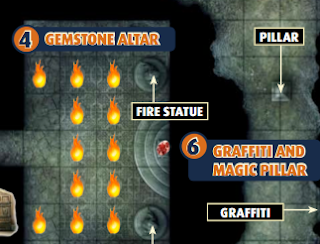My first post about the Beginner Box focused on the Hero’s Handbook, which contains the rules for creating PCs. Here I am going to talk about the referee side of the set, the Game Master’s Guide. It starts out with a simple dungeon adventure which is not bad, despite the fact that the map really does look like a set of video game screen shots. However, later on in their section on creating dungeons, they do use a more down to earth map that looks like it was drawn by hand and even make the following remark on page 31:
Your dungeon maps don’t need to look professionally drawn like the map for Black Fang’s Dungeon—the hand-drawn map of Raven’s Watch works just as well.
This is a strategy used several places in the Beginner Box; they lead with glitz and then qualify their recommendations further on, and it works well most of the time.
 |
| Excerpt from Black Fang’s Dungeon |
There is a decent selection of monsters (forty-something) and some of them are moderately high CR, but there is not as much variety or content as the old basic sets. Each monster entry takes half of a page. The higher-CR monsters include salamander (CR 6), medusa (CR 7), manticore (CR 5), mummy (CR 5), ghost (CR7), and black dragon (CR 8). There is a bias towards enemies that can be defeated directly, but at least they included some stretch targets. And poison is so weak now. If you fail your save against giant spider venom you get all of a -1 on attack and damage rolls (cumulative if you get hit again). Seriously, that’s it.
The XP rewards for defeating monsters are off the charts! A ½ CR zombie gives 200 XP. I guess that’s what happens when you take away treasure XP, but I would think that some of the slack would be picked up by XP for solving puzzles, surviving traps, and achieving other goals. I think OD&D gives 100 XP per hit die, but those monsters are far deadlier. Using the rules as written, I bet PCs would level really quickly.
 |
| Dragon Warrior Monsters |
Much info is presented in random table form, including adventure seeds, magic items, and most importantly encounters. This is another case where they wrote something (on page 84) that made me cringe:
By using the random encounter tables for that terrain, you can create fun battles for the PCs without putting in a lot of work.
But then corrected it it shortly thereafter (same page):
Although these tables are filled with monsters, you can have interesting non-combat random encounters, such as a strange statue, corpses from a battle, religious pilgrims looking for a shrine, and so on.
It would be nice if they had emphasized that not all monster encounters need to be combat either. Speaking of which, I really feel the lack of the traditional social mechanics. There are no rules for retainers, encounter reactions, or morale. This is the single biggest shortcoming of Pathfinder. Of course, it would not be that hard to house rule them in, though you would need to make up appropriate morale numbers. I also miss the “number appearing” and “percent chance in lair” info.
I think it might be fun to use literally nothing outside of the Beginner Box for a game. Use the town of Sandpoint and the surrounding hinterlands. Populate them using all of the entries on the d12 table of “dungeon storylines” and the seven sample “additional quests.” And make sure all the monsters have a place. Maybe roll for enmities. Another attractive option that comes to mind is to use the Third Edition Necromancer Games world and modules, but still cap the PC level at 5. So, if the player’s want to take on the harder challenges, they will need to be very creative.

I think it is important to note that Pathfinder is important to the Old School in many ways.
First, there is a greater respect for the company amongst fans.
Second, we almost all grow from the same root (the SRD) and if ever we needed our own 800lb gorilla in the room we are surely growing one and that is why I feed it bananas. It’s one thing if someone tried to shut down the small publishers with threats of lawsuits, but not only would a bluff not work it would be the end of D&D as we know it. Imagine every SRD based system forced out of existence and then the hand of ‘unity and friendship’ extended from a giant monopoly who hasn’t satisfied the fans as a whole in 4, now going on 5, tries.
It would be open warfare.
I like Paizo…I like them a LOT.
I don’t have a whole lot of experience with the company first hand, but there are a lot of positive things I have noticed. The Planet Stories pulp imprint, for example.
This is an interesting point from a legal perspective. It is certainly good to have a big company with the same interests as the smaller clones. I suspect that if there is any challenge to the OGL, the free software community would get involved as well, because the OGL was inspired by the GPL (and similar licences), and weaknesses found in one might affect others.